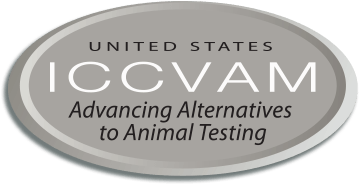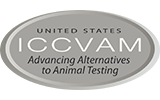Acronyms and Abbreviations
3Rs: principles of replacement, reduction, or refinement of animal use for scientific research or product safety testing
ADME: absorption, distribution, metabolism, and excretion
AERO-TOX: aerosol exposure of respiratory organ-on-a-chip for toxicology
AIME: alginate immobilization of metabolic enzymes
ALI: air-liquid interface
ALTBIB: Bibliography on Alternatives on the Use of Live Vertebrates in Biomedical Research and Testing
AOP: adverse outcome pathway
API: application programming interface
ATSDR: Agency for Toxic Substances and Disease Registry
AWIC: Animal Welfare Information Center (U.S. Department of Agriculture)
CAR: chimeric antigen receptor
CATMoS: Collaborative Acute Toxicity Modeling Suite
CBC: Chemical Biological Center (U.S. Army, U.S. Department of Defense)
CCTE: Center for Computational Toxicology and Exposure (U.S. Environmental Protection Agency)
CDER: Center for Drug Evaluation and Research (U.S. Food and Drug Administration)
CEBS: Chemical Effects in Biological Systems (National Institute of Environmental Health Sciences)
CFSAN: Center for Food Safety and Applied Nutrition (U.S. Food and Drug Administration)
CHRIS: Chemical Risk Calculator Tool (U.S. Food and Drug Administration)
cHTS: curated high-throughput screening
CPDat: Chemicals and Products Database (U.S. Environmental Protection Agency)
CPSC: U.S. Consumer Product Safety Commission
CRADA: cooperative research and development agreement
CYP450: cytochrome P450
devTOXqP: devTOX quickPredict assay (Stemina, Inc.)
DL-GLF: DL-glufosinate ammonium
DNT: developmental neurotoxicity
DNT-DIVER: Developmental NeuroToxicity Data Integration and Visualization Enabling Resource (National Institute of Environmental Health Sciences)
DoD: U.S. Department of Defense
DOE: U.S. Department of Energy
DOI: U.S. Department of the Interior
DOT: U.S. Department of Transportation
DSA: dose per skin area
DSSTox: Distributed Structure-Searchable Toxicity (U.S. Environmental Protection Agency)
dTP: developmental toxicity potential
DTT: Division of Translational Toxicology (National Institute of Environmental Health Sciences)
EAD: equivalent administered dose
EASA: electrophilic allergen screening assay
ECOSAR: Ecological Structure Activity Relationships (U.S. Environmental Protection Agency)
eDNA: environmental DNA
EDSP: Endocrine Disruptor Screening Program (U.S. Environmental Protection Agency)
ENM: engineered nanomaterials
EPA: U.S. Environmental Protection Agency
eSTAR: Emerging Systems Toxicology for the Assessment of Risk (Health and Environmental Sciences Institute)
EURL ECVAM: European Union Reference Laboratory for Alternatives to Animal Testing
FAIR: findability, accessibility, interoperability, and reusability (of data)
FDA: U.S. Food and Drug Administration
GenRA: Generalized Read-across (U.S. Environmental Protection Agency)
GHS: United Nations Globally Harmonized System of Classification and Labeling of Chemicals
hERG: human ether-a-go-go related gene
HESI: Health and Environmental Sciences Institute
HPPT: human predictive patch test
HTS: high-throughput screening
httk: High-throughput Toxicokinetics (software package, U.S. Environmental Protection Agency)
HTTr: high-throughput transcriptomics
IATA: integrated approach to testing and assessment
ICATM: International Cooperation on Alternative Test Methods
ICCVAM: Interagency Coordinating Committee on the Validation of Alternative Methods
ICE: Integrated Chemical Environment (National Toxicology Program)
ICH: International Council for Harmonisation of Technical Requirements for Pharmaceuticals for Human Use
iPSC: induced pluripotent stem cell
IQ MPS: Innovation and Quality Microphysiological Systems
ISTAND: Innovative Science and Technology Approaches for New Drugs (U.S Food and Drug Administration)
IVIVE: in vitro to in vivo extrapolation
JaCVAM: Japanese Center for the Validation of Alternative Methods
JRC: Joint Research Centre (European Commission)
LC50: in traditional acute inhalation or aquatic toxicity tests, the concentration that produces lethality in 50% of the animals tested
LD50: in traditional acute dermal or oral systemic toxicity tests, the dose that produces lethality in 50% of the animals tested
LEL: lowest-effect level
LOAEL: lowest observable adverse effect level
MPS: microphysiological system
MPSCoRe: MPS for COVID Research working group
NAM: new approach methodology
NASA: National Aeronautics and Space Administration
NC3Rs: National Centre for the Replacement Refinement & Reduction of Animals in Research (United Kingdom)
NCATS: National Center for Advancing Translational Sciences (National Institutes of Health)
NCI: National Cancer Institute (National Institutes of Health)
NICEATM: National Toxicology Program Interagency Center for the Evaluation of Alternative Toxicological Methods
NIEHS: National Institute of Environmental Health Sciences (National Institutes of Health)
NIH: National Institutes of Health
NIOSH: National Institute for Occupational Safety and Health
NIST: National Institute of Standards and Technology
NLM: National Library of Medicine (National Institutes of Health)
NRF2: nuclear factor erythroid 2-related factor 2
NTP: National Toxicology Program
OECD: Organisation for Economic Co-operation and Development
OHT201: OECD Harmonized Template 201
OPERA: Open (Quantitative) Structure-activity/property Relationship App
OSHA: Occupational Safety and Health Administration
PACT: Promise to Address Comprehensive Toxics [Act]
PAH: polycyclic aromatic hydrocarbon
PBA: pharmaceutical-based agent
PBK: physiologically based kinetic
PBPK: physiologically based pharmacokinetic
PFAS: per- and polyfluoroalkyl substances
PK: pharmacokinetic
POD: point of departure
PPARg: peroxisome proliferator-activated receptor gamma
PRT: Predictive Risk Team (U.S. Air Force, U.S. Department of Defense)
QSAR: quantitative structure-activity relationship
REST APIs: representational state transfer architectural style application programming interfaces
SACATM: Scientific Advisory Committee on Alternative Toxicological Methods
SARA: Skin Allergy Risk Assessment model (Unilever)
SARA-ICE: Skin Allergy Risk Assessment-Integrated Chemical Environment model
SEAZIT: Systematic Evaluation of the Application of Zebrafish in Toxicology (National Toxicology Program)
SEEM3: Systematic Empirical Evaluation of Models (U.S. Environmental Protection Agency)
SeqAPASS: Sequence Alignment to Predict Across Species Susceptibility (U.S. Environmental Protection Agency)
SOT: Society of Toxicology
STopTox: Systemic and Topical chemical Toxicity
tcpl: ToxCast data pipeline (U.S. Environmental Protection Agency)
tDOA: taxonomic domain of applicability
ToxCast: Toxicity Forecaster (U.S. Environmental Protection Agency)
ToxRefDB: Toxicity Reference Database (U.S. Environmental Protection Agency)
TSCA: Toxic Substances Control Act (U.S. Environmental Protection Agency)
USAF: U.S Air Force (U.S. Department of Defense)
USDA: U.S. Department of Agriculture
USGS: U.S. Geological Survey (U.S. Department of the Interior)
VEGF: vascular endothelial growth factor
VEGFR: vascular endothelial growth factor receptor
Vmax: maximal capacity for metabolism
VOC: volatile organic chemical
Web-ICE: Web-based Interspecies Correlation (U.S. Environmental Protection Agency)



